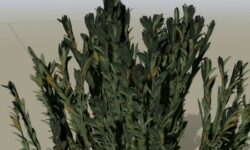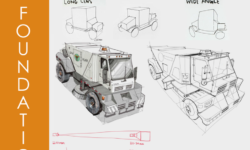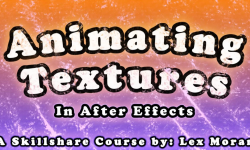Release date:2020, October 15
Author:Lionel VICIDOMINI
Skill level:Beginner
Language:English
Exercise files:Yes
In this second volume, you will learn everything there is to know about modeling!
Polygon modeling is at the core of every 3D application. Whatever field you are going to work in, you will need to know how to push points, edges and polygons to make your vision come true.
I’m Lionel VICIDOMINI, a Maxon Certified Instructor, Maxon Master Trainer and Motion Designer based in Paris, France. I believe that in order to truly master a software you have to learn it by the details. I have created this series of training, to create a video manual of Cinema 4D and to be the most thorough possible while being entertaining.
In this training you will learn :
How to select, move, scale and rotate polygons precisely, fluently, and as fast as possible to allow a smoother workflow
All about splines, those vector shapes that are so useful when you want to create complex objects
The generators, such as the mirror, the remesher and the all-powerful Subdivision Surface, at the very core of polygon modeling
The polygon commands, such as the extrude, bevel tool, but also the stich’n’sew and many less known tools
The deformers, which allow you to reshape objets to your needs or even create whole models from simple primitives
OpenVDB modeling, another way to create complex objects parametrically without the hassle of polygons
Several workshops in the end of the course will teach you real life examples and how to model many objects : a screw, a spoon, a coffee cup and its holder, a soccer ball and many others.
This training has been recorded on the R23 but you can follow it easily on previous versions of the software, down to R17.
It is not required to have followed the first volume of the series, but it can greatly help, especially if you are new to 3D.
Watch online or Download for Free
01. The Core Concepts of Polygons
02. Installing the custom interface
03. What is a polygon
04. What is a N-Gone
05. The Structure Manager
06. The normals
07. The Phong Tag
08. Selecting Points, Edges and Polygons
09. The Grow, Shrink, Connected selections
10. The Loop, Ring, Outline, Path and Fill Selections
11. Placing the Axis Where you Want
12. Orienting the Axis
13. Soft Selection
14. Creating Vertex Maps
15. Painting Vertex Maps
02. The Splines
01. Welcome to the Wonderful World of Spline
02. Opening, Closing Splines, Moving Points Around
03. Changing the Type of Spline
04. Join, Break, Explode Splines
05. Creating a Freeform Spline with the Pen
06. Draw a Spline with the Sketch Tool
07. Smoothing, Relaxing, Twisting the Splines
08. The Arc Tool
09. Adding, Deleting, Welding Points
10. Adding Points with the Rounding Command
11. Mirroring Splines
12. Projecting Spline on a Surface
13. The Line Up and Magnet Commands
14. Converting Edges of an Object to a Spline
15. Creating Cross Sections
16. Importing from Illustrator
17. The Chamfer and Outline Command
18. Combining Shapes with the Spline Mask
19. Creating a Biohazard Shape with the Direct Boolean Commands
03. The Generators
01. What are the Generators
02. What is interpolation and why its important
03. The Caps panel
04. The rounding option on caps
05. The Extrude Generator
06. The Lathe Generator
07. Modeling a glass with the lathe generator
08. The Sweep Generator
09. The Sweep Generator the Rail option
10. The Sweep Generator Scale and rotation options
11. The Loft Generator
12. The Metaballs
13. Better control of the Metaball with the tag
14. The Connect object
15. The Symmetry Object
16. The Polygon Reduction object
17. The Level of Detail (LOD) object
18. The LOD advanced options
19. The Cloth Surface object adding thickness
04. Mastering the polygon commands
01. The Subdivision Surface generator
02. Weighting the Subdivision Surface mastering hard edges
03. Advanced options of the Subdivision Surface
04. The Remesher (R23 and up)
05. Better topology in the Remesher with the Spline Flow (R23 and up)
06. Dissolving, melting, collapsing, deleting polygons
07. Optimize command
08. Subdivide
09. Splitting, disconnecting geometries
10. Ngons commands
11. Moving, scaling, rotating along normals
12. The Line Cut command
13. Loop cut
14. Plane cut
15. Connecting edges or points
16. Fast extrusion with the move, rotate and scale tool
17. Extrude command
18. Smooth shift command
19. Matrix extrude
20. Extrude inner
21. Bridge command
22. Close polygon hole
23. The Bevel tool Solid Mode
24. The Bevel tool Chamfer Mode
25. The Bevel tool Topology
26. The Bevel tool Points
27. The Bevel tool beveling polygons
28. Welding points
29. Stitching points
30. The Slide tool
31. Spinning edges
32. The Iron tool
33. The magnet and brush tool
34. The Mirror command
35. Set Point Value
36. Clone, arrray tool
37. Remove Manifold
38. The Polygon Pen, 1st part
39. The Polygon Pen, 2nd part
40. The Polygon Pen, retopology on a shoe
05. The Deformers
01. What are the Deformers, and what they can do for you
02. The basics of Deformers
03. Alignement of Deformers
04. The Deformer Mode
05. Hierarchy and Order of Operations
06. Restricting a Deformer with a Field
07. Restricting a Deformer with the Restrict Tag
08. Bend deformer
09. Twist deformer
10. Bulge and Taper Deformers
11. Shear deformer
12. Freeform deformer (FFD)
13. Mesh deformer
14. Correction deformer
15. Melt, shatter and explosion deformers
16. Spherify deformer
17. Surface deformer
18. Shrink Wrap deformer
19. Wrap deformer
20. Spline Wrap deformer
21. Spline Wrap deformer Rail option
22. Spine Rail deformer
23. Spline deformer
24. Formula deformer
25. Wind deformer
26. Displacer deformer, 1st part
27. Displacer deformer, 2d part
28. Camera deformer
29. Bevel deformer
06. Using OpenVDB for modeling (R20 and up)
01. What is OpenVDB
02. Creating a coffee cup with OpenVDB
03. Using meshes with OpenVDB
04. Using spline with OpenVDB
05. Using Mograph, Particles and Fields with OpenVDB
06. Refining the coffee cup
07. Modeling a screw with OpenVDB
08. Modeling a vase
09. Creating the pattern on the vase
10. Finishing the vase
11. The smoothing filters
12. The dilate, close and open filters
13. Playing with Fields and OpenVDB
14. The fog volume
15. Animating a title with the Fog Volume
16. Override the grid matrix option
17. Importing VDB
18. Exporting VDB
19. The Volume Loader
07. Modeling Workshops
01. Checking your mesh
02. Setting up reference images
03. Setting up reference images with planes
04. Modeling a heart
05. Modeling a banana
06. Modeling a banana using the Spline Wrap
07. Modeling a dice
08. Refining the dice
09. Modeling a soccer ball
10. Modeling a coffee cup
11. Modeling the coffee cup holder
12. Modeling a spoon
13. Modeling a fancy spoon
14. Finishing the fancy spoon
15. Cutting holes – 1st Part
16. Cutting holes – 2nd Part
17. Creating a complex hardsurface shape
18. Modeling a designer chair the base
19. Modeling a designer chair the feet
20. Finishing the designer chair, creating iterations with deformers
21. Modeling a screw the main body
22. Modeling a screw finishing the top
23. Modeling a jug
24. Modeling a cow moneybox
25. Modeling a cow moneybox refining the shape
26. Modeling a cow moneybox wrapping up
[Udemy] Cinema 4D Complete – Vol. 2. All about Modeling!_Subtitles.7z
[Udemy] Cinema 4D Complete – Vol. 2. All about Modeling!.7z
Join us on
 Channel and
Channel and  Group
Group





 Channel
Channel





